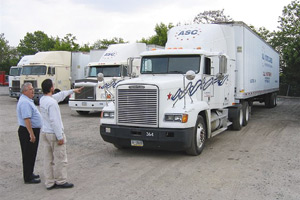FMCSA Panel Takes Fresh Look at Entry-Level Driver Training

This story appears in the March 9 print edition of Transport Topics.
ARLINGTON, Va. — The Federal Motor Carrier Safety Administration has kicked off its latest effort to produce a rule on minimum training standards for entry-level commercial vehicle drivers — a goal of the U.S. government since 1985.
FMCSA is bringing many of the nation’s top industry stakeholders to the table in an attempt to draw up a proposed “negotiated rulemaking.”
To that end, and in compliance with a congressional mandate that the agency issue an entry-level driver-training rule, FMCSA’s 26 member advisory committee held its first meeting here Feb. 26-27.
The committee’s charge is for at least 23 of the members to reach agreement on a detailed outline of what should be in the rule. The members are from trade associations representing trucking, school buses, motor coach lines, truck driver training schools, government agencies and safety advocacy.
Though it’s an optimistic task, the committee’s facilitator, Richard Parker, a University of Connecticut law professor with experience in leading negotiated rulemakings, told FMCSA in a report late last year that creating a rule was clearly worth another shot.
“The stakeholders I interviewed support the process without exception,” Parker wrote. “Most of these stakeholders (though not all) expressed interest in participating in the process themselves and are ready to roll up their sleeves and get to work.”
But Parker added this caveat: “Reaching complete consensus will not be easy and is by no means assured — particularly given the potential cost of meaningful standards and the lack of empirical data currently linking various training inputs and levels of effort to safety outcomes.”
Parker issued a plea at the meeting that committee members use their connections to carriers, insurance providers and truck driver training schools to secure the data needed to fashion a rule that will stand rigorous regulatory review by the Office of Management and Budget.
Based on the language in the MAP-21 highway funding law, FMCSA staff said, the rule will cover the training that would-be truck and bus drivers must receive before they take a commercial driver license test.
This rule covers all Classes 7-8 trucks, those with gross-vehicle-weight ratings in excess of 26,000 pounds. It also will cover drivers of light- and medium-duty trucks if they are driving hazardous materials that require placards.
The committee expects to complete negotiations by May 29 and file a final report by June 15.
The inaugural meeting was largely introductory, outlining the mission and ways to accomplish it. Subcommittees were created to foster curriculum, certification and accreditation, cost-benefit analysis, and implementation and enforcement.
Committee member Boyd Stephenson, director of hazardous materials policy for American Trucking Associations, said all 26 committee members are united in their desire to see a training rule implemented.
“The real challenge is going to be finding some ways to concretely demonstrate in some real hard numbers that the benefits of the rule are there,” Stephenson said. “But we all have to face the fact that the effort might not work.”
Peter Kurdock, director of regulatory affairs for Advocates for Highway and Auto Safety, said his group finds “FMCSA’s delay to be unconscionable.”
“Our concern is that [the negotiated regulation] provides meaningful training and meaningful safety outcomes,” Kurdock said. “We’re hopeful that that can happen. But it’s going to be a challenge.”
Other members of the committee include Carl Spatocco of the Commercial Vehicle Training Association, Clyde Hart, acting FMCSA administrator during the Clinton administration and now an executive with the American Bus Association; union representation from the AFL-CIO and the Teamsters; David Heller of the Truckload Carriers Association; two people representing owner-operators; Louis Spoonhour, a manager for refrigerated carrier Stevens Transport; and Kevin Lewis, director of driver programs for the American Association of Motor Vehicle Administrators.
The two-day meeting, while not contentious, did reveal that a successful proposed rule will support clear safety benefits.
FMCSA staff specialist Rich Clemente told committee members the quest for training standards started when the Federal Highway Administration began working on a model curriculum in 1985, 15 years before FMCSA was created.
In December 2007, FMCSA proposed a rule that drew 700 comments. It was withdrawn in 2013 without receiving final approval.
Larry Minor, FMCSA’s associate administrator for policy, said several issues have played a role the delays.
“Based on the reactions to our 2007 notice of proposed rulemaking, there were a couple of key issues, such as certification and accreditation [of training schools], and performancebased versus hoursbased [training requirements],” Minor told Transport Topics. “Those were the key issues.”
Separately, Steven Smith, director of FMCSA’s Office of Analysis, Research and Technology, told committee members his office is conducting a driver survey and other research to document the ways entry-level driver training improves safety.
But the research will not be done in time for the panel to use, raising concerns a lack of data will prevent any proposal from gaining approval.
The committee will next meet on March 19-20.

